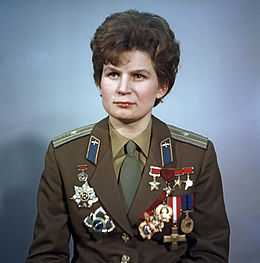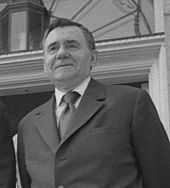Belarusians in Russia
| |||||||||
| Total population | |||||||||
|---|---|---|---|---|---|---|---|---|---|
|
800.000 0.6% of the population of Russia | |||||||||
| Regions with significant populations | |||||||||
| Moscow · St. Petersburg · Smolensk Oblast · Bryansk O. · Kaliningrad O.. | |||||||||
| Languages | |||||||||
| Russian · Belarusian | |||||||||
| Religion | |||||||||
| Russian Orthodox Church · Roman Catholicism · Atheism · Judaism | |||||||||
Belarusians are a major ethnic group in Russia. In the census of 2002 807,970 Russian citizens confirmed their Belarusian ethnicity.[1] Major Belarusian groups live in the regions of Moscow, St. Petersburg, Kaliningrad, Karelia. Most Belarusians in Russia are migrants from modern Belarus or their descendants, while a minor part of Belarusians in Russia are indigenous.
Geography

A minor part of Belarusians in Russia are original inhabitants of the Russian-Belarusian border regions. In ancient times the regions of Smolensk and Pskov were inhabited by the East Slavic tribe of Krivichi that later became major base of the Russian and Belarusian nations. The Russian town of Smolensk was several times conquered by Polatsk dukes and belonged to the Grand Duchy of Lithuania between 1408 and 1514.
According to the census of the Russian Empire, some Belarusians lived in the territories of modern Smolensk Oblast, Bryansk Oblast. A small number of Belarusians used to live in the modern Kaluga Oblast, Pskov Oblast, Orel Oblast.
The Korenization policies of the 1920s encouraged Belarusians of Russia to promote and develop Belarusian cultural life and education. A system of Belarusian schools was established in Western Russia. In the 1930s, the Korenization was reversed and its proponents were repressed.
Moscow
During the Polonization of the Grand Duchy in the 16th and 17th centuries, a large number of Orthodox Ruthenians, led by Princes Mstislavsky, Belsky and Galitzine, escaped the repressions to Moscow. In documents of that time they are also called Litvins or White Ruthenians.
One of the compact settlements of Litvins in Moscow was the Meschanskaya Sloboda. Its inhabitants engaged in financial operations, trade, and medicine. Meschanskaya Sloboda had a degree of self-governance and a collegiate church.
In the times of Imperial Russia and the USSR, Moscow as the scientific and economic centre of the country attracted many specialists from different parts of the empire including Belarus. So, the minister of foreign affairs of the USSR during the most tensed period of the Cold War was the Belarusian Andrei Gromyko.
Today, Moscow also attracts huge numbers of specialists for constant and temporary work. Every year hundreds of students from Belarus join Moscow universities.
St. Petersburg
After the Partition of Poland, Belarusians started migrating to Russia including the imperial capital, St. Petersburg. Especially many peasants from northern and eastern regions of Belarus migrated to St. Petersburg.
According to statistics, from 1869 to 1910 the number of Belarusians in St. Petersburg grew 23 times and reached 70,000. By the end of that period Belarusians were the biggest ethnic minority in the city.[2] During the First World War for some period up to one million Belarusians lived in the city because of inflow of refugees.[3]
In the second half of the 19th century, several Belarusian organisations were created in St. Petersburg uniting intellectuals and students. In 1868 the enlightenment organisation Kryvitski vazok was founded. In the 1880s the organisation of leftist Belarusian intellectuals Homan was created. Along with Wilno, St. Petersburg has been the centre of Belarusian cultural an intellectual life in the late 19th century. A Belarusian publishing house existed in St. Petersburg in 1906-1912. Belarusian scientists at the universities of St. Petersburg made important ethnographic researches about Belarus.
The activity of organisations of Belarusian diaspora continued after the October Revolution until it was violently stopped by Stalinist repressions.
During the Perestroika, several new Belarusian diaspora organisations appeared in Leningrad. Today St. Petersburg, though less than Moscow, is also attractive for workers and students from Belarus.
Siberia
Siberia was goal for mass migrations from Belarus in the 19th century. First, Russians deported participants of January November uprisings. During the period 1885–1914, 550 thousand Belarusians settled to Siberia. Entire Belarusian villages existed there.
After the October Revolution, the stream of migrants from Belarus to Siberia did not stop. The Soviets tried to organise their flow and sanctioned several researches on the history and traditions of Siberian Belarusian. In 1929 the National Academy of Sciences of Belarus organised a special ethnographic expedition to Siberia. In the census of 1926 371,840 Siberians stated their Belarusian descent.
Korenization allowed the Belarusian minority in RSFSR to develop its culture and language. Belarusian schools were created in Siberia.
In the 1930s and early 1940s many Russian, Ukrainian, and Belarusian intellectuals and peasants were deported to Siberia, including those from West Belarus when annexed to the BSSR.
In the late 1980s the Belarusian national revival movement also affected Siberian Belarusians. Jan Cherski Society for Belarusian Culture was established in Irkutsk and is now the largest and most active organisation of the Belarusian diaspora in Russia.
Other regions
In the 18th century Belarusians lived in several gubernyas of European Russia. Belarusian settlements existed in Kursk, Pensa gubernyas and in the Ural.
After cancellation of serfdom in Russia in the 19th century, mass migrations of Belarusian peasants to Russia started. Main goals were Volga region, Caucasus, Central Asia and Siberia.
From the late 1940s to early 1960s many Belarusians settled in Karelia, Arkhangelsk Oblast, the Komi Republic, and Kaliningrad Oblast.
Belarusian territorial autonomies in Russia
Belarusian national revival in RSFSR in early Soviet times included creation of Belarusian local autonomies - national Rural Soviets (сельсоветы) inside raions. In 1924–1926, 71 Belarusian rural soviets were created in Siberia. In 1926 there were 26 Belarusian rural soviets in the Russian Far East. In the Ural in 1928 there were eleven. Later, several Belarusian raiony, administrative units of a higher level, were created. In the early 1930s there was a Belarusian national raion of Taboryn as part of the Ural oblast. There was a discussion about the creation of a Belarusian national unit inside the Omsk oblast.
In the mid-1930s all Belarusian autonomies inside the RSFSR were liquidated.
Modern state
Number of Belarusians in Russia
| Year | Population |
|---|---|
| 1959 | 844,000 |
| 1970 | 964,700 |
| 1989 | 1,206,000 |
| 2002 | 807,970 |
Because of cultural closeness of Belarusians to Russians and weakly expressed national identity, Belarusians are more than other ethnic minorities exposed to assimilation in Russia. Despite mass inflow of migrants from Belarus during last centuries, children of immigrants rarely identify themselves as Belarusians.
Currently, more and more Belarusian organisations are created in different regions of Russia.
In 2003 a Belarusian cultural society Belorusy Yugry was registered in Surgut.
The largest and strongest Belarusian diaspora organisation in Russia is the Jan Čerski Society for Belarusian Culture in Irkutsk. The organisation unites descendants of Belarusian settlers in Siberia, and has several branches and issues a newspaper.
In Moscow there is the Frantsishak Skaryna Society for Belarusian Culture and an informal union of Belarusian students. In Bashkortostan there is a Belarusian national cultural centre Siabry founded in 1996. In Kaliningrad Belarusians are united in the culture society Karalaviec.
In the last decade Belarusian community of Russia is of separate opinion on the current presidency of Alexander Lukashenko. Some organisations support the democratic opposition. Other, more recently founded organisations as the Federal National Cultural Autonomy of Belarusians in Russia are supported by the embassy of Belarus, and have a more positive opinion on the policies of the government.
Besides Russian citizens of Belarusian descent, there are about 400 thousands Belarusians currently working in Russia.[4]
Notable Russians of Belarusian origin
- Fyodor Dostoyevsky, writer, descendant of a Polesian szlachta family
- Mikhail Glinka, composer, descendant of Smolensk szlachta
- Dmitry Shostakovich, composer, descendant of a participant of the November uprising
- Several Russian noble families (Trubetskoy, Belsky and others) were originally Belarusian szlachta that fled to Muscovy
- Alexander Bogdanov
- Maria Sharapova Tennis player
- Pavel Sukhoi, constructor and designer
- Anatoly Chubais, Russian politician and business manager
References
- ↑ http://www.perepis2002.ru/ct/html/TOM_04_01.htm
- ↑ http://by.ethnology.ru/win/belinspb.htm
- ↑ Мікалай Нікалаеў. Беларускі Пецярбург; http://www.zvyazda.minsk.by/ru/issue/article.php?id=39501
- ↑ http://finance.rol.ru/news/article02D6C/default.asp
External links
- Russia and Belarus: an ethnocultural dialogue (in Russian)
- Maskva.net - a web portal of Belarusians in Moscow (in Belarusian and Russian)
- Peoples of Russia: Belarusians (in Russian)
- A hundred Belarusian villages in Siberia (article in Belarusian)
- Federal National Cultural Autonomy of Belarusians in Russia (in Russian)
| ||||||||||||||
| ||||||||||||||||||







